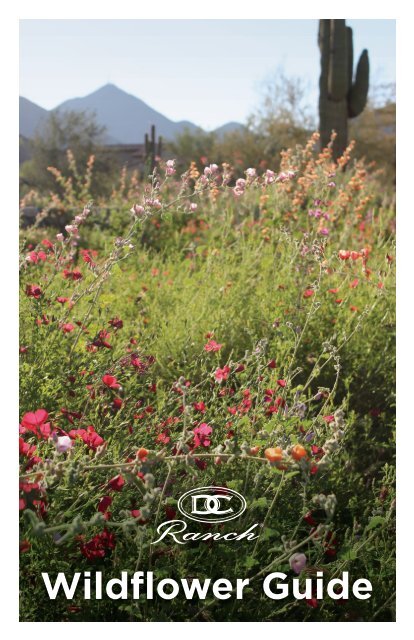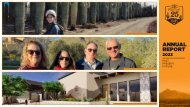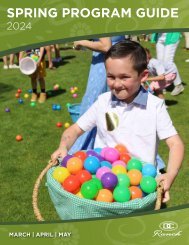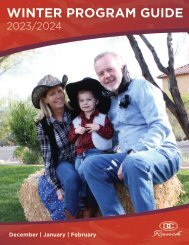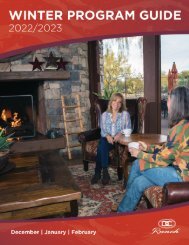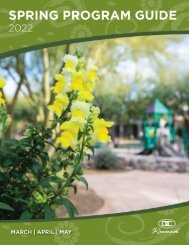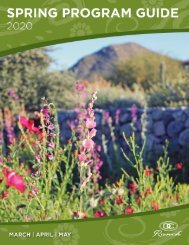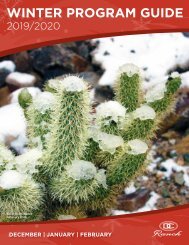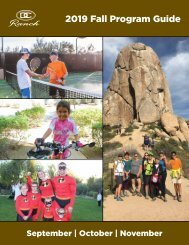Wildflower Guide
You also want an ePaper? Increase the reach of your titles
YUMPU automatically turns print PDFs into web optimized ePapers that Google loves.
<strong>Wildflower</strong> <strong>Guide</strong>
<strong>Wildflower</strong> Program at DC Ranch<br />
The <strong>Wildflower</strong> Program at DC Ranch is one of the hallmarks of<br />
DC Ranch’s unique desert character. Each spring, residents enjoy<br />
displays of wildflowers that have been carefully planted and<br />
cared for by the landscape team.<br />
The <strong>Wildflower</strong> Program, planned and implemented under the<br />
Developer Agreement with the City of Scottsdale more than 20<br />
years ago, is a way to celebrate the unique desert setting. It has<br />
also become one of the largest native wildflower displays in Arizona.<br />
<strong>Wildflower</strong> Mix<br />
%<br />
Each year, a special mix of wildflowers is created. Look<br />
for this symbol to see what percentage of the mix each<br />
type of wildflower makes up.<br />
Images may not be reproduced without permission.<br />
1%<br />
Desert Marigold | Baileya multiradiata<br />
Showy desert marigold is a 12-18 in.,<br />
mound-shaped biennial or short-lived perennial.<br />
The flowers, which occur sporadically over<br />
a long bloom period, turn papery with age.<br />
The name Marigold, given to several species of<br />
Asteraceae with sunny yellow or orange<br />
flowers, comes from “Mary’s Gold,” in honor of<br />
the Virgin.
8%<br />
Plains Coreopsis | Coreopsis tinctoria<br />
Numerous smooth, slightly angled branches<br />
bearing showy, daisy-like flower heads with<br />
yellow rays surrounding a reddish-purple<br />
central disk. This prevailingly western annual<br />
has escaped from cultivation in the East.<br />
Because of its showiness, the flower is cultivated<br />
extensively, hence its common name.<br />
5%<br />
Desert Senna | Cassia covesii<br />
In the United States Senna covesii is found in<br />
AZ, CA and NM. In Arizona it is found almost<br />
state-wide with few or no records in the<br />
northeast part of the state. Its flowers attract<br />
Carpenter Bees and Bumblebees. Sulphur<br />
Butterflies use the plant as a larval food<br />
source.<br />
8%<br />
Cosmos | Cosmos bipinnatus<br />
Warm weather annual that is easily grown in<br />
average, well-drained soils in full sun. Cosmos<br />
bipinnatus, commonly just called cosmos, is<br />
native to Mexico. It is a popular, low-maintenance,<br />
late-blooming, showy annual that typically grows<br />
2-4’ tall on erect stems clad with pinnatisect,<br />
medium green leaves that are deeply cut into<br />
threadlike segments.<br />
5%<br />
Sulphur Cosmos | Cosmos sulphurascens<br />
Klondike Cosmos have golden-yellow or<br />
orange flowers and can grow up to 6 feet.<br />
When the spring-planted cosmos appears to<br />
have an abundance of dried seed, do not<br />
remove the plants. Encourage re-bloom by<br />
cutting the plants back to 12 to 18 inches high.
8%<br />
California Poppy | Eschscholtzia californica<br />
The California poppy is native to grassy and open<br />
areas from sea level to 6,500 feet in the western<br />
United States throughout California, extending to<br />
Oregon, southern Washington, Nevada, Arizona,<br />
New Mexico, and in Mexico in Sonora and northwest<br />
Baja California. It can grow 5-60 centimeters<br />
tall, with alternately branching waxy pale<br />
blue-green foliage.<br />
6%<br />
Indian Blanketflower | Gaillardia pulchella<br />
Firewheel or indian blanket is a popular annual<br />
growing 1-2 ft. tall. The hairy stem is usually<br />
much-branched and becomes woody at the<br />
base late in the season. Frequent along roadsides<br />
in the Southwest, these wildflowers<br />
stand like hundreds of showy Fourth of July<br />
pinwheels at the top of slender stalks.<br />
8%<br />
Wallflower | Erysimum capitatum<br />
An extremely variable species, though usually a<br />
clumped plant with densely crowded clusters of<br />
orange, yellow, orange-brown or purplish-maroon<br />
flowers atop each minimally-branched<br />
stem. The narrow leaves and stems of this<br />
biennial to short-lived perennial are hairy. The<br />
seedpods stand upright.<br />
6%<br />
Mexican Gold Poppy | Eschscholtzia mexicana<br />
A low, smooth, pale bluish-green plant with<br />
fern-like leaves, mostly near base, and<br />
orange-yellow, cup-shaped flowers borne<br />
singly on stalks. Mexican gold poppy is a<br />
small, somewhat sprawling perennial, 6-16 in.<br />
tall and wide. The Spanish name, Amopalo del<br />
Campo, means “poppy of the countryside.”
1%<br />
Pink Evening Primrose | Oenothera speciosa<br />
Originally native only to central grasslands<br />
from Missouri and Nebraska south through<br />
Kansas, Oklahoma, and Texas to northeastern<br />
Mexico, Pink Ladies or Pink Evening Primrose<br />
is an upright to sprawling, 1 1/2 ft. perennial,<br />
which spreads to form extensive colonies. Its<br />
large, four-petaled flowers range in color from<br />
dark pink to white.<br />
7%<br />
Bladderpod | Lesquerella gordonii<br />
Gordon’s bladderpod is a hairy annual with a<br />
silvery gray appearance. Stems, up to 16 in.<br />
long, may be trailing or erect and are<br />
much-branched. Flowers are yellow and are<br />
followed by spherical, inflated fruit pods on<br />
curving stalks.<br />
3%<br />
Desert Lupine | Lupinus sparsiflorus<br />
Pale blue, 1/2-inch long blue to lilac flowers<br />
bloom on slender, erect stems January through<br />
May. The upper petal (banner) has a yellow spot<br />
which changes to reddish after pollination. The<br />
two bottom petals (keel) are short, and wide;<br />
they are hairy on the bottom edge and curve<br />
upward to a slender tip.<br />
2%<br />
Fivespot | Nemophila insignis<br />
Fivespot is a species of flowering plant in the<br />
Borage family. It is endemic to California. In<br />
the wild it is found primarily in the Sierra<br />
foothills, but it is also planted extensively in<br />
gardens. The flowers are bowl-shaped consisting<br />
of five petals, white with dark veins and<br />
dots. The lobe tips are purple-spotted, leading<br />
to the common name.
8%<br />
Scarlet Flax | Linum grandiflorum v. rubrum<br />
Scarlet Flax is a hardy annual and provides a<br />
bright splash of colour in the summer months.<br />
It has tall, thin stems with narrow leaves, all in a<br />
glaucous greyish-green, with spectacular<br />
rounded flowers about an inch and a half<br />
across in bright crimson with a deeper centre<br />
leading to a solid black eye, with a matching<br />
deeper rim to each petal.<br />
1%<br />
Tansy Aster | Machaeranthera tanacetifolia<br />
Branched stems with fern-like leaves ending in<br />
flower heads with many bright purple, very<br />
narrow rays surrounding a yellow central disk.<br />
Tahoka Daisy is a low, spreading, 6-12 in.<br />
annual with delicate but showy, aster-like<br />
flowers. Numerous lavender rays surround a<br />
yellow center.<br />
2%<br />
Baby-Blue-Eyes | Nemophila menziesii<br />
A small, trailing annual, 6 in. tall and 1 ft. wide,<br />
Menzies baby-blue-eyes is well-known for its<br />
bright-blue, five-petaled, bowl-shaped flowers<br />
with white centers. These occur in clusters at<br />
branch tips.<br />
2%<br />
Red Corn Poppy | Papavear rhoeas<br />
Corn Poppy is an annual herbaceous species of<br />
flowering plant in the poppy family native to<br />
Europe and Asia. Red blooms last only a day<br />
but are numerous in spring and again in fall.
5%<br />
Wild Pink Snapdragon | Penstemon palmeri<br />
A member of the Plantaginaceae (Plantain)<br />
family, notable for its showy, rounded flowers.<br />
This plant grows erect and may reach two<br />
meters in maximum height but more often less.<br />
The leaves are generally oppositely arranged<br />
and have toothed margins. The flower cluster is<br />
a panicle or raceme with small leaves.<br />
3%<br />
Prairie Conerflower | Ratibida columnaris<br />
A plant branched and leafy in lower part with<br />
long leafless stalks bearing flower heads of<br />
3-7 yellow or yellow and red-brown, drooping<br />
rays surrounding a long, red-brown central<br />
disk. Its sombrero-shaped flower heads, is<br />
usually 1 1/2 ft. tall but can reach 3 ft. Flower<br />
petals range from dark red and yellow, to all<br />
red or all yellow.<br />
2%<br />
Parry’s Penstemon | Penstemon parryi<br />
Long spikes of pink, tubular flowers line the<br />
upper portion of this perennial’s 2-3 ft. stems.<br />
The flowers occur in clusters at the ends of<br />
short, paired stalks. Several erect, sparsely<br />
leaved stems with pinkish-lavender, bilaterally<br />
symmetrical flowers in a long, open,<br />
interrupted cluster.<br />
8%<br />
Desert Bluebells | Phacelia campanularia<br />
An 8-16 in. annual with 1 in. wide, bell-shaped,<br />
deep-blue flowers. The flowers, with protruding<br />
golden anthers, are arranged in rolled, 1-sided<br />
racemes; the raceme unrolling as the flowers<br />
open. A stiff, erect, leafy, glandular-hairy plant<br />
with dark blue, bell-like flowers in loose coils at<br />
end of a branched open cluster. Leaves are<br />
round to oval.
Tips to Stay Safe<br />
Watch the weather<br />
Check the weather before you head out. There is a<br />
heat warning in effect April to October. Hike in the<br />
early morning or evening when it's cooler.<br />
Dress appropriately<br />
Wear hiking or athletic shoes, a hat and sunscreen.<br />
Loose fitting clothing may get stuck or caught on<br />
desert vegetation.<br />
Bring water<br />
Hydrate before you leave. Bring plenty of water<br />
with you. Turn around and head back before your<br />
water is halfway gone.<br />
Keep in contact<br />
Carry a cell phone and tell someone where you are<br />
going and when you expect to return.<br />
Be a courteous and cautious pet owner<br />
Dogs must be kept on a leash. Please clean up after<br />
them. Be mindful of the heat.<br />
Don’t trailblaze<br />
Stay on the designated paths and trails. Respect<br />
the desert plant life. Do not pick wildflowers.<br />
Respect the wildlife<br />
Never approach or feed wildlife. Observe quietly<br />
from a distance.


